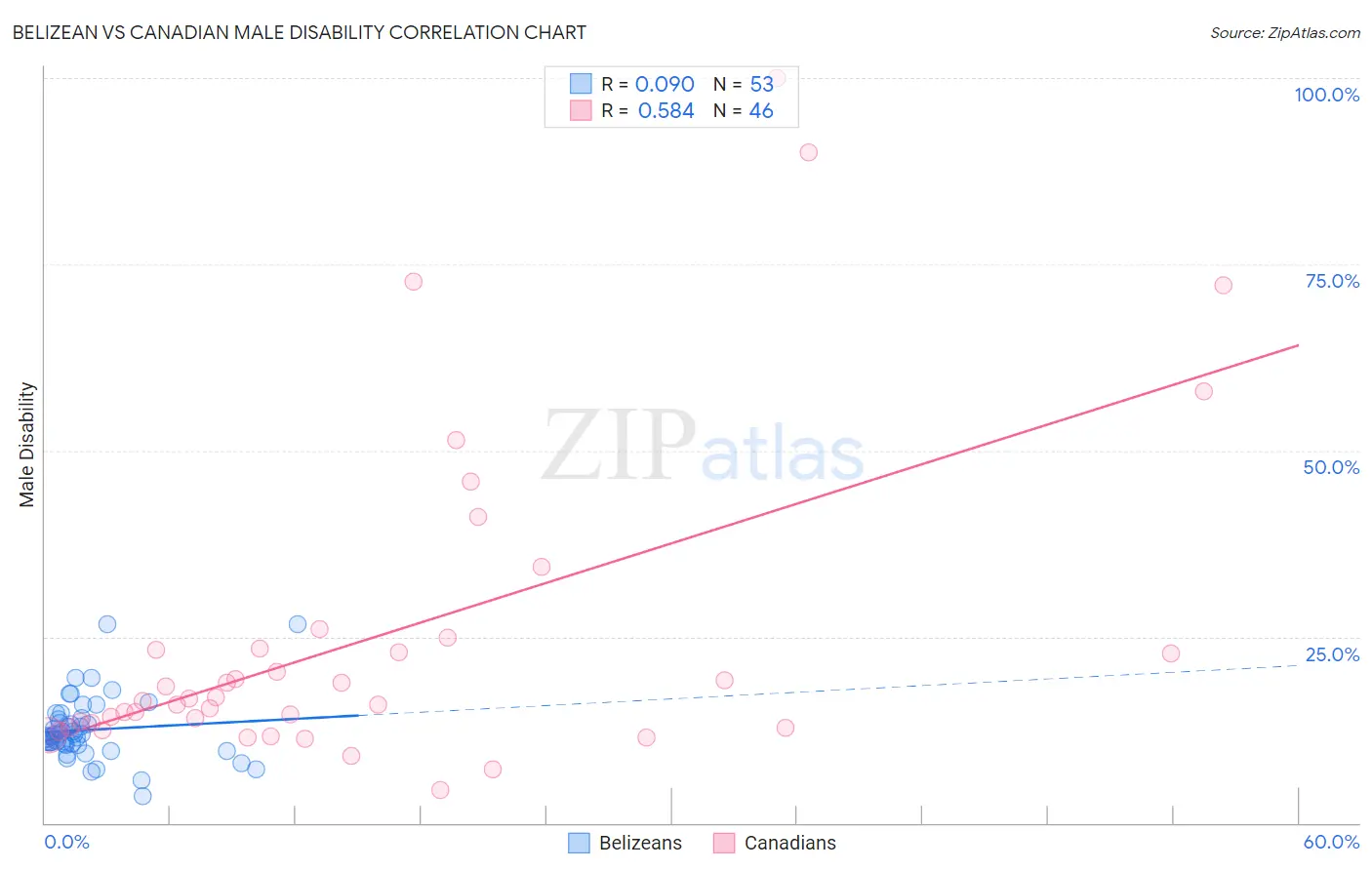Belizean vs Canadian Male Disability
COMPARE
Belizean
Canadian
Male Disability
Male Disability Comparison
Belizeans
Canadians
11.4%
MALE DISABILITY
21.2/ 100
METRIC RATING
194th/ 347
METRIC RANK
12.2%
MALE DISABILITY
0.2/ 100
METRIC RATING
263rd/ 347
METRIC RANK
Belizean vs Canadian Male Disability Correlation Chart
The statistical analysis conducted on geographies consisting of 144,197,719 people shows a slight positive correlation between the proportion of Belizeans and percentage of males with a disability in the United States with a correlation coefficient (R) of 0.090 and weighted average of 11.4%. Similarly, the statistical analysis conducted on geographies consisting of 437,467,484 people shows a substantial positive correlation between the proportion of Canadians and percentage of males with a disability in the United States with a correlation coefficient (R) of 0.584 and weighted average of 12.2%, a difference of 6.8%.

Male Disability Correlation Summary
| Measurement | Belizean | Canadian |
| Minimum | 3.6% | 4.4% |
| Maximum | 26.7% | 100.0% |
| Range | 23.1% | 95.6% |
| Mean | 12.5% | 25.0% |
| Median | 11.6% | 16.5% |
| Interquartile 25% (IQ1) | 10.6% | 12.7% |
| Interquartile 75% (IQ3) | 14.0% | 23.4% |
| Interquartile Range (IQR) | 3.4% | 10.7% |
| Standard Deviation (Sample) | 4.3% | 21.6% |
| Standard Deviation (Population) | 4.2% | 21.3% |
Similar Demographics by Male Disability
Demographics Similar to Belizeans by Male Disability
In terms of male disability, the demographic groups most similar to Belizeans are Immigrants from Oceania (11.4%, a difference of 0.030%), Greek (11.4%, a difference of 0.080%), Assyrian/Chaldean/Syriac (11.4%, a difference of 0.15%), Senegalese (11.4%, a difference of 0.16%), and West Indian (11.4%, a difference of 0.24%).
| Demographics | Rating | Rank | Male Disability |
| Immigrants | Austria | 27.3 /100 | #187 | Fair 11.4% |
| Estonians | 26.8 /100 | #188 | Fair 11.4% |
| Immigrants | Netherlands | 25.9 /100 | #189 | Fair 11.4% |
| Immigrants | Bosnia and Herzegovina | 25.4 /100 | #190 | Fair 11.4% |
| Senegalese | 23.2 /100 | #191 | Fair 11.4% |
| Assyrians/Chaldeans/Syriacs | 23.2 /100 | #192 | Fair 11.4% |
| Greeks | 22.2 /100 | #193 | Fair 11.4% |
| Belizeans | 21.2 /100 | #194 | Fair 11.4% |
| Immigrants | Oceania | 20.9 /100 | #195 | Fair 11.4% |
| West Indians | 18.4 /100 | #196 | Poor 11.4% |
| Somalis | 18.2 /100 | #197 | Poor 11.4% |
| Immigrants | Jamaica | 16.3 /100 | #198 | Poor 11.5% |
| Lebanese | 15.4 /100 | #199 | Poor 11.5% |
| Immigrants | Iraq | 13.0 /100 | #200 | Poor 11.5% |
| Immigrants | Panama | 13.0 /100 | #201 | Poor 11.5% |
Demographics Similar to Canadians by Male Disability
In terms of male disability, the demographic groups most similar to Canadians are Nepalese (12.2%, a difference of 0.030%), Norwegian (12.2%, a difference of 0.20%), Slavic (12.2%, a difference of 0.21%), Immigrants from Portugal (12.3%, a difference of 0.49%), and Hawaiian (12.3%, a difference of 0.51%).
| Demographics | Rating | Rank | Male Disability |
| Swiss | 0.3 /100 | #256 | Tragic 12.1% |
| Europeans | 0.3 /100 | #257 | Tragic 12.1% |
| Basques | 0.3 /100 | #258 | Tragic 12.1% |
| Belgians | 0.3 /100 | #259 | Tragic 12.1% |
| Swedes | 0.3 /100 | #260 | Tragic 12.1% |
| Slavs | 0.2 /100 | #261 | Tragic 12.2% |
| Norwegians | 0.2 /100 | #262 | Tragic 12.2% |
| Canadians | 0.2 /100 | #263 | Tragic 12.2% |
| Nepalese | 0.2 /100 | #264 | Tragic 12.2% |
| Immigrants | Portugal | 0.1 /100 | #265 | Tragic 12.3% |
| Hawaiians | 0.1 /100 | #266 | Tragic 12.3% |
| Immigrants | Germany | 0.1 /100 | #267 | Tragic 12.3% |
| Portuguese | 0.1 /100 | #268 | Tragic 12.3% |
| Czechoslovakians | 0.1 /100 | #269 | Tragic 12.3% |
| Spaniards | 0.1 /100 | #270 | Tragic 12.3% |